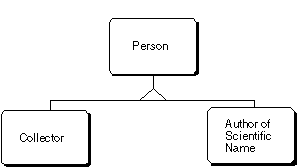
Here defined as a network diagram depicting a number of entities together with the relationships connecting them. The diagram is read along the connecting lines, starting with the entity name, followed by the descriptive text nearest to it, then the cardinality (i.e., how many instances of the second entity are referred to the instance in the first one) and, finally, the name of the second entity.
The cardinality may be "1" (exactly 1), "C" (0 or 1), "N" (1 to many), or "CN" (0 to many). The "C" is for conditional relationship, i.e. it is possible that no instance is referred to. Example:

Diagram 2: ER-diagram
Reads: A scientific name has exactly 1 corresponding name rank. A name rank is assigned to 0 to many scientific names.
In some cases it may be appropriate to assign some of the attributes of an entity to a separate entity, because they are used only under specific circumstances. For example, a collector as well as the author of a taxon name is a person, but there are a number of attributes referring only to taxon authors or to collectors. Such "is-a" relationships may be expressed by classification relationships (Person being the super-entity, Author of Scientific Name a subtype). A super-entity is connected to its sub-entities with a line marked by a triangle. Example:

Diagram 3: Classification relationship (subtyping)
Reads: Person may be a collector and/or an author of a scientific name.
This is an inclusive relationship (and/or), represented by the outline of a triangle, i.e. a person may be a collector and/or an author. If the relationship was to be exclusive, the triangle would be filled. An equal sign within the triangle indicates that the classification is complete, i.e. only the subtypes shown exist.
Up to now, relatively few database management systems give direct support for subtyping. However, in traditional systems subtypes may be implemented either by directly including the subtype's attributes in the super entity, or by including the attributes of the supertype in the subtypes, or by forming 1-to-C relationships between super entity and subtype. The two latter possibilities are not supported by relational systems, application programming code must handle data input and integrity.